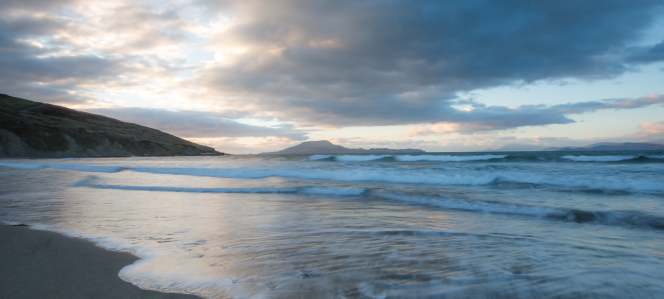More than 30 years ago, a storm swept away a beachfront in Dooagh, Achill Island, off the County Mayo coast of Ireland. The entire beach was washed away, leaving a scenic but also craggy coast, treadable only by the hardiest of souls, wearing the hardiest of soles.
Around Easter of 2017, the beachfront reappeared overnight. A member of the Achill Island tourism board suggested that a cold snap and a steady north wind probably deposited the sand on its shores. Tourists immediately visited the beach, walking shoeless.
It’s an enchanting story and as it is situated in Ireland, it almost begs for an accompanying bit of freewheeling blarney—something about “the little people” being miffed at the locals for some reason and taking away their beach only to restore it when their pique had run its course.
But as I read about the reappearing beach, what struck me was what a working metaphor it was for our lives—both the material and the spiritual, the worldly life and the life of faith. It brings us a lesson about how the world and everything in it is continually in flux. What is alive is constantly in motion, sometimes obviously—like the waves pounding upon every ocean’s coast, or the wind bending a tree or raising a beach—and sometimes imperceptibly.
Right now, for instance, if your body is operating as it should, your red blood cells are collecting oxygen through your lungs and then transporting it throughout your body tissue by way of your heart, enlivening every bit of your tissue, but you don’t notice it.
Similarly, if your religious practices are being kept up, prayers and sacraments and devotions are, in a manner of speaking, bringing oxygen to your spirit in a strengthening and sustaining way. They are keeping your spiritual life alive, even as you attend to material things.
Thus, what is living is always changing in big and small ways, always resisting stasis and stagnation by living within the thrust and tension of a moment. It is adaptive. “A dead thing can go with the stream, but only a living thing can go against it,” observed G.K. Chesterton. That’s very true, of course, and only a living thing can evolve as needed, too.
Still, as the beach of Achill Island demonstrates, heavy weather will change things, cut new lines, expose new ground that must still be traveled, but always with an eye to the gauge of one’s sole, and of course, one’s soul.
It’s like that, right now, in Catholic evangelism. We are many decades away from the days of fully-enrolled Catholic schools giving instruction in the faith to children who had those lessons reinforced at home. That culture, which even featured a Catholic bishop, Fulton Sheen, hosting a show during network prime time, has become fundamentally and forever changed; those beachheads have been washed away. We are on newly exposed ground, requiring a new way to step.
The heavy storms of late have created a new mood too; people are not very open just now. They’re closing in on themselves and their secular-socio communities, tolerating fewer differences of thought, opinion, or practice, and religious instruction—or outright evangelism—they want not at all.
Mother Angelica once told a story about an agnostic visitor to her Abbey who refused a gift of one of the nun’s books. When asked why she didn’t want the book, the woman said, “If I read that, I might have to change, and I don’t want to.”
This is the challenge facing Christians who feel called to give witness to the life in Christ: evangelistic outreach invites others to consider Jesus of Nazareth and his teachings, which are all about becoming free in deep and authentic ways that cannot easily be imagined by those who see religion as a swampland of “No” when all they really want to hear is “Yes.” Many people fear giving any opening to an evangelist because they intuit that the True Yes they may find there, like true north, might navigate them away from what feels familiar and socially safe.
Like Bartleby the Scrivener, they would prefer not to.
But the life in Christ, particularly one lived with promise of sacramental graces, enriched by devotions and traditions and the whole communion of saints, is a life that is lived completely in “Yes,” and therefore in never ending possibility and potential—so alive that it leaps forward against the stream to find the next chance to say “Yes.”
It is the job of the evangelist to convey the excitement and energy that comes from understanding one’s gifts, discerning one’s mission within the plans of Christ, and then cooperating with the Creator for the furtherance of his purposes, which are—along with the Incarnation—“for all the people.”
And we cannot waste time bemoaning the loss of our comfortable earlier holdings because Christ is coming and—as with the beachfront in Dooagh—he may show up just that suddenly, and that unexpectedly, and asking us why we have permitted souls to be lost as we dithered about whether flip-flops or thick soles are the best way to manage the new landscape.
The living world, constantly in flux, is deeply in need of a living Church to walk within it in the hopes of rescuing some who’ve wandered too near a cliff, pulling others back from fast current or a dangerous riptide, inviting still others to rest in a light that will bathe but never consume, unless one asks it to.
Things being as they are, the living Church needs all of us to step up. The more I realize just how much she needs us—how much Christ needs us—in this work, the more excited I am to watch the continued growth of the Word on Fire Institute, and the communities of new lay evangelists beginning to be formed and made ready for the walking. It is a challenging time to be a Catholic. And an exciting one, as well. Do not be afraid.
